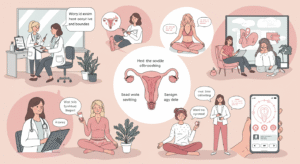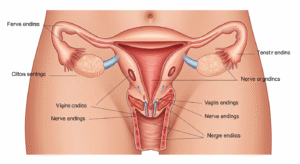What are intercourse problem?
When people say intercourse problems they usually mean difficulties that happen during genital intercourse — pain with penetration (superficial or deep), inability to have comfortable intercourse, arousal or orgasm difficulties that arise during sex, or psychological blocks (like vaginismus). These problems cause distress or lead partners to avoid sex, and that distress is a valid reason to seek help.
How common are they?

Rates vary by study and definition, but painful sex and related intercourse problems are common. Large clinical reviews and guidelines show a substantial number of women experience persistent pain or discomfort during sex at some point — many do not seek care, which keeps the problem hidden longer than it needs to be. You are not alone.
Common causes
Intercourse problems almost always have more than one contributor. Here are the usual categories clinicians check:
- Local pelvic conditions (physical/pelvic)
- Vaginal dryness or genitourinary syndrome of menopause (GSM).
- Vaginal infections (yeast, bacterial vaginosis) or sexually transmitted infections.
- Vulvodynia (chronic vulvar pain) or vaginismus (involuntary pelvic floor tightening).
- Endometriosis, pelvic inflammatory disease, fibroids or scarring that cause deep pain.
- Medical & hormonal
- Hormone shifts (pregnancy, postpartum, perimenopause/menopause) reduce lubrication and sensitivity.
- Chronic diseases (diabetes, thyroid disease, neurological conditions) can impair sensation or blood flow.
- Medications (some antidepressants, hormonal contraceptives) may lower arousal and lubrication.
- Psychological & relational
- Past sexual trauma, anxiety about sex, depression or body image issues.
- Relationship stress, poor communication or mismatched desire. Psychological factors often maintain a physical problem and vice-versa.
Because these layers interact, a successful plan usually combines medical, pelvic and psychological approaches.
Immediate, safe steps you can try today
These are low-risk and often help quickly — try them consistently for 2–6 weeks and note changes.
- Use a good water-based lubricant for penetration-related discomfort (immediate relief for dryness).
- Avoid scented soaps/irritants around the vulva; use gentle, pH-neutral products.
- Prioritize foreplay and non-penetrative intimacy — longer arousal reduces pain and improves comfort.
- Limit alcohol before sex — alcohol may reduce sensitivity and increase painful encounters.
- Practice pelvic relaxation and breathing — slow diaphragmatic breathing before intimacy relaxes pelvic floor tension.
- Keep a simple diary of painful episodes, timing, medications, and menstrual cycle to share with your clinician.
If pain is severe, sudden, or accompanied by fever or abnormal bleeding, seek medical attention promptly.
When to see a clinician
See a healthcare professional if intercourse problems persist, cause distress, or you can’t identify a clear trigger. A good assessment usually includes:
- Detailed history (onset, pattern, meds, childbirth/surgery, psychological history).
- Examination: external vulvar inspection and pelvic exam to look for infections, atrophy, masses, scarring or pelvic floor tenderness.
- Targeted tests only when they will change management (swabs for infection, pregnancy test, selective blood tests).
- Referral to pelvic physiotherapy, sexual medicine, or mental health specialists as needed.
Guidelines stress that patients should be asked about sexual concerns in routine care; don’t be surprised if you need to bring it up — many clinicians wait for patients to mention these issues.
Sex medicine and treatments that work
Treatment is tailored to the cause(s). Below are frequently used, evidence-based options.
1. Treat the local cause first
- Infections (yeast, BV, STIs): treat with appropriate antimicrobials — this often resolves superficial pain quickly.
- Vaginal atrophy/GSM: low-dose vaginal estrogen (creams, tablets, or ring) is highly effective for menopausal vaginal dryness and dyspareunia. Alternatives such as ospemifene may be used in some cases.
2. Pelvic floor physiotherapy
- Pelvic physiotherapists teach relaxation, desensitization, and graded vaginal dilator programs — essential for vaginismus, pelvic floor spasm or some forms of dyspareunia. Clinical reviews show good outcomes with targeted pelvic therapy.
3. Topical analgesics & targeted local treatments
- Topical lidocaine or compounded formulations can help localized vestibular pain before intercourse. For some women with vulvodynia, topical approaches reduce pain enough to allow progression to therapy.
4. Psychotherapy & sex therapy
- Cognitive behavioural therapy (CBT), trauma-informed therapy and sex therapy address anxiety, fear and relationship factors. For many women, combining therapy with pelvic physiotherapy is the best path.
5. Medication review and systemic treatments
- Review medications: if an SSRI or other drug contributes to low desire or dryness, the prescriber may change therapy.
- Targeted sex medicine: hormonal therapies, or in select cases, off-label treatments and specialist pharmacologic options can be considered — only after careful assessment. Professional bodies emphasize individualized decision-making.
Simple care pathway (what a typical plan looks like)
- First visit: history, exam, treat obvious infections, start lubricants/moisturizers.
- 2–6 week review: assess response; add pelvic physiotherapy or topical treatments if pain persists.
- 3 months: if limited improvement, add sex therapy and reconsider medical options or specialist referral (gynaecology, sexual medicine).
This stepwise model keeps care practical and minimizes unnecessary tests or treatments.
Helpful enhancements — checklists, conversation starters & exercises
Clinic appointment checklist
- When pain started and pattern (superficial vs deep; only with penetration or always).
- Recent infections, childbirths, surgeries, or new medications.
- Menstrual cycle notes and sexual activity record.
- One or two goals you want from treatment (e.g., pain-free penetration, increased comfort with pelvic exam).
Conversation starters with a partner
- “I’ve had pain during intercourse lately and I’d like your support while I see a doctor.”
- “Can we focus on non-penetrative closeness for a few weeks while I work on this?”
At-home exercises to try (with clinician guidance)
- Pelvic relaxation practice: 5–10 minutes of diaphragmatic breathing and pelvic relaxation daily.
- Sensate focus: slow, non-sexual touch sessions to rebuild safe, positive sensation.
- Graded insertion (for vaginismus): with a physiotherapist’s plan, use progressively larger dilators to retrain muscles.
Author & review box
Author: Dr. Kusuma — Founder, Female Sexual Health by Dr. Kusuma — 10 years’ clinical experience in gynecology and sexual medicine.
Clinic address: Androcare — Swetha Scans, 67-A, Journalist Colony, Road No. 70, Jubilee Hills, Hyderabad — 500033.
Website: femalesexualhealth.in
Phone: 91 9000218377
Clinical reviewer: Senior gynecologist / sexual medicine consultant (content checked against clinical guidance from ACOG, StatPearls and major clinic resources).
FAQ
Q: What’s the difference between superficial and deep pain?
Q: Will using lubricant make intercourse problems go away?
Q: Is painful sex always caused by something serious?
Q: How long before I feel better?
Final practical takeaway
Intercourse problems are common and treatable. Start with simple self-care — lubricant, gentle products, more foreplay and pelvic relaxation — and book a clinical review if symptoms persist. A clear, stepwise plan that uses sex medicine, pelvic physiotherapy and therapy where needed helps most women return to comfortable intimacy.
If you’re in Hyderabad and want confidential, evidence-based care, Female Sexual Health by Dr. Kusuma at Androcare — Swetha Scans (67-A, Journalist Colony, Road No. 70, Jubilee Hills, Hyderabad — 500033) offers multidisciplinary assessment and treatment. Visit femalesexualhealth.in for appointments and resources.






